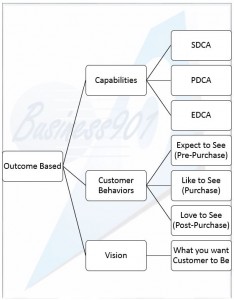The last few weeks I have been writing a post a week on how my marketing has transformed over the past several years. I started with, 7 Simple Steps to Improve Your Marketing and followed up with Revisiting the 7 Steps to Improve Your Marketing. Today, I will visit what I might call my current state marketing outline. I have used a 7 Step outline.
As I progress from what you might call a traditional marketing approach in my first 7 Steps and gradually becoming more customer-focused, I moved to the traditional flow that was depicted in the following diagram labeled Value Stream Marketing and explained in a blog post, A Scrum Drawing for Lean Marketing. This approach eventually led to the development of Lean Marketing House: A starting point for creating true iterative marketing cycles based on not only Lean principles but more importantly Customer Value.

My current approach centers on the Funnel of Opportunity, using an Outcome Based Mapping approach. In this approach depicted on the right, I look at our capabilities, customer behaviors that we are trying to change and of course the over-arching vision. A brief overview of each block: 
1. Standard Work (SDCA): Define core business and put the majority of company resources into the core until it achieves its full potential.
2. Continuous Improvement (PDCA): Most big ideas are made up of a series of successful smaller ideas driven by a simple and repeatable business model.
3. New Markets and Products (EDCA): After defining what it cannot do and exploring what it may want to do?
4, 5, 6. Customer Behaviors: In the Outcome-Based Mapping approach, we view the outcomes as the central part of our theme. We recognize that a change of behavior must occur for us to achieve our goals or make the desired impact that wish to obtain. In traditional sales and marketing we can develop the simplest of all marketing funnels based on (4)pre-purchase, (5)purchase (buy), and (6)post purchase. We have a tendency to complicate this into numerous steps and activities. When we view an outcome-based approach we like to separate the group very similarly into (4)Expect to see, (5)like to see and (6)love to see.
The strength in this process is that you look for changes in behaviors versus trying to move a customer/prospect down a path. When you view your customers/prospects in a linear path, it becomes a manipulative path towards a transactional event. If we view the process as a set of outcomes, we work towards understanding and agreement. In each of these columns, we list progress markers that demonstrate positive movement towards changes of behaviors, actions, activities or relationships of our customers. These changes allow us to support our partner towards a more meaningful outcomes while empowering a more cooperative relationship.
7. Vision: Michael Schrage, author of Serious Play, published a book taking these concepts one step further. Who Do You Want Your Customers to Become? challenges us to take our value proposition of use to a longer term growth platform. He dares us not only to have a corporate vision statement, but a customer vision statement saying that our future depends on their future. He phrases all this in something he calls “The Ask.” I discuss this concept in more detail in a blog post, Shaping your Customers Vision.
I happen to be a big proponent of understanding your own capabilities and working from your strengths, see my musing in the Lean Scale-Up. This leads to a different way of engagement, a strength-based approach over the traditional problem-solving approach. I think working from a vision of opportunity allows you a clearer vision and more direct approach.
Mix this approach with Tony Ulwick (What Customers Want) thinking of Outcome-Driven Innovation (Jobs, Outcomes, Constraints), where he claims that these three distinct outcomes are what organizations need to know in their marketing practices. Expanding on them….
- Jobs (to be Done) are the tasks or activities that customers are trying to get done
- Outcomes are what customers are trying to achieve
- Constraints something that may prevent a customer from using a product or service
This really provides the foundation of my present work which I can summarize actually in three steps.
1. Capabilities: Define my work and how much time, resources and money I will devote to each area.
2. Understand my Customer Behaviors (What Customers Want)
3. Provide a Vision (What You Want Your Customer to Be)
